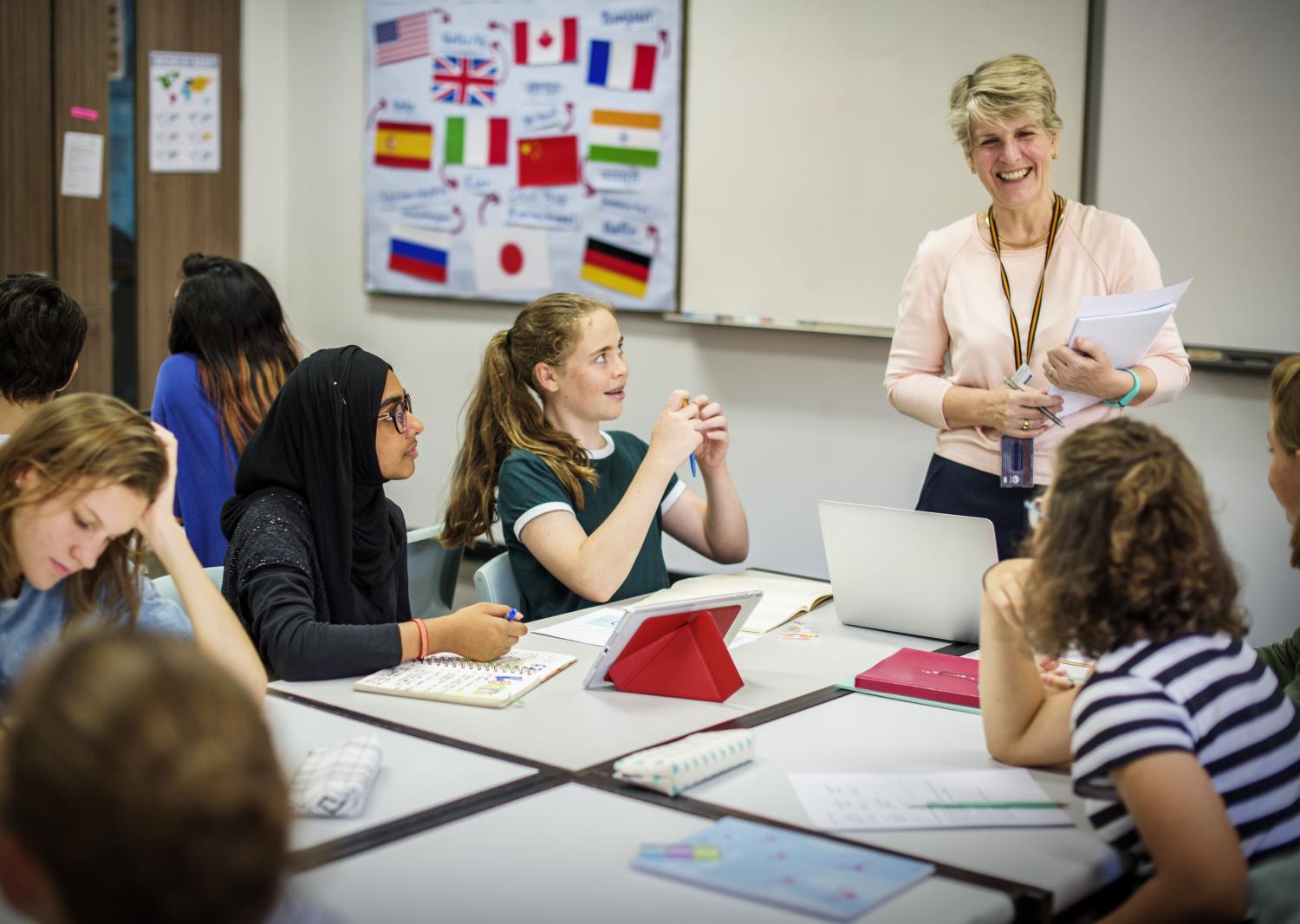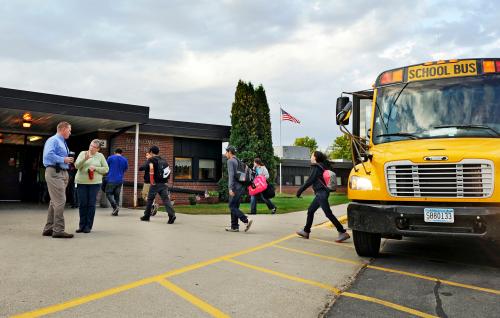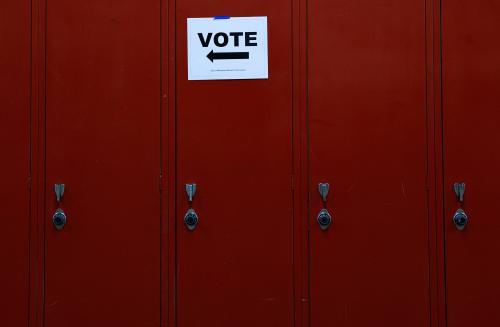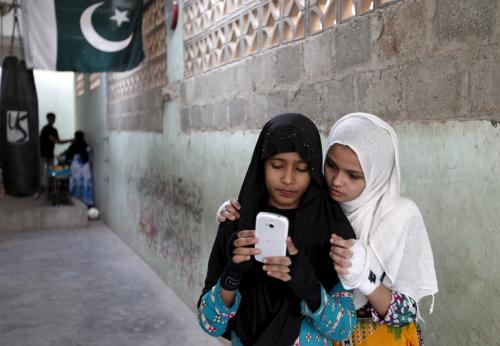Americans’ participation in civic life is essential to sustaining our democratic form of government. Without it, a government of the people, by the people, and for the people will not last. Of increasing concern to many is the declining levels of civic engagement across the country, a trend that started several decades ago. Today, we see evidence of this in the limited civic knowledge of the American public, 1 in 4 of whom, according to a 2016 survey led by Annenberg Public Policy Center, are unable to name the three branches of government. It is not only knowledge about how the government works that is lacking—confidence in our leadership is also extremely low. According to the Pew Research Center, which tracks public trust in government, as of March 2019, only an unnerving 17 percent trust the government in Washington to do the right thing. We also see this lack of engagement in civic behaviors, with Americans’ reduced participation in community organizations and lackluster participation in elections, especially among young voters.1
Many reasons undoubtedly contribute to this decline in civic engagement: from political dysfunction to an actively polarized media to the growing mobility of Americans and even the technological transformation of leisure, as posited by Robert D. Putnam. Of particular concern is the rise of what Matthew N. Atwell, John Bridgeland, and Peter Levine call “civic deserts,” namely places where there are few to no opportunities for people to “meet, discuss issues, or address problems.” They estimate that 60 percent of all rural youth live in civic deserts along with 30 percent of urban and suburban Americans. Given the decline of participation in religious organizations and unions, which a large proportion of Americans consistently engaged in over the course of the 20th century, it is clear that new forms of civic networks are needed in communities.
As one of the few social institutions present in virtually every community across America, schools can and should play an important role in catalyzing increased civic engagement. They can do this by helping young people develop and practice the knowledge, beliefs, and behaviors needed to participate in civic life. Schools can also directly provide opportunities for civic engagement as a local institution that can connect young and old people alike across the community. To do this, civic learning needs to be part and parcel of the current movement across many schools in America to equip young people with 21st-century skills.
To date however, civic education experts argue that civic learning is on the margins of young people’s school experience. The 2018 Brown Center Report on American Education examined the status of civic education and found that while reading and math scores have improved in recent years, there has not been the commensurate increase in eighth grade civics knowledge. While 42 states and the District of Columbia require at least one course related to civics, few states prioritize the range of strategies, such as service learning which is only included in the standards for 11 states, that is required for an effective civic education experience. The study also found that high school social studies teachers are some of the least supported teachers in schools and report teaching larger numbers of students and taking on more non-teaching responsibilities like coaching school sports than other teachers. Student experience reinforces this view that civic learning is not a central concern of schools. Seventy percent of 12th graders say they have never written a letter to give an opinion or solve a problem and 30 percent say they have never taken part in a debate—all important parts of a quality civic learning.
The origins of civic education
The fact that children today across the country wake up in the morning and go to school five days a week for most of the year has everything to do with civic education. The idea of a shared school experience where all young people in America receive a standard quality education is inextricably linked to the development of the United States as a national entity and the development of citizens who had the skills and knowledge to engage in a democracy.
In the early 1800s, as the country struggled to navigate what it meant to be a democratic republic, school as we know it did not exist as a distinguishing feature of childhood. Even almost midway into the century—in 1840—only 40 percent of the population ages 5 to 19 attended school.2 For those who did attend, what they learned while at school was widely variable depending on the institution they attended and the instructor they had. Several education leaders began advocating for a more cohesive school system, one in which all young people could attend and receive similar instruction regardless of economic status, institution, or location. Chief among these leaders was Horace Mann, often referred to as the “father of American education,” who argued that free, standardized, and universal schooling was essential to the grand American experiment of self-governance. In an 1848 report he wrote: “It may be an easy thing to make a Republic; but it is a very laborious thing to make Republicans; and woe to the republic that rests upon no better foundations than ignorance, selfishness, and passion.”
The rise of reading, math, and science
The Common Schools Movement that Mann helped establish and design was the foundation of our current American education system. Despite the fact that the core of our education system was built upon the belief that schooling institutions have a central role to play in preparing American youth to be civically engaged, this goal has been pushed to the margins over time as other educational objectives have moved to the forefront. Reading, math, and science have always been essential elements of a child’s educational experience, but many educationalists argue that these subjects were elevated above all others after the country’s “Sputnik moment.” In 1957, the Soviet Union’s launch of Sputnik, the first space satellite, made waves across the U.S. as Americans perceived they were falling behind academically and scientifically. A wave of reforms including in math, science, and engineering education followed. Improving students poor reading and math skills received particular attention over the last several decades including in President George W. Bush’s No Child Left Behind Act. A focus on ensuring American students get strong STEM (science, technology, engineering, and math) skills continues to be an ongoing concern, as highlighted by President Obama’s 2013 Educate to Innovate plan focused on improving American students performance in STEM subjects.
The case for incorporating 21st-century skills
Civic learning experts, however, are not the only ones concerned about the perceived narrow focus on reading, math, and science in American schools. In recent years, there has been a growing movement for schools to help students develop “21st-century skills” alongside academic competencies, driven in large part by frequent reports of employers unsatisfied with the skills of recent school graduates. Business leaders point out that they not only need employees who are smart and competent in math and reading and writing, they also need people who can lead teams, communicate effectively to partners, come up with new ways to solve problems, and effectively navigate an increasingly digital world. With the rise of automation, there is an increasing premium on non-routine and higher order thinking skills across both blue collar and white collar jobs. A recent study of trends in the U.S. labor market shows that social skills that are increasingly in demand3and many employers are struggling to find people with the sets of skills they need.
Advances in the science of learning have bolstered the 21st-century skills movement. Learning scientists argue that young people master math, reading, and science much better if they have an educational experience that develops their social and emotional learning competencies—like self-awareness and relationship skills which are the foundation of later workplace skills—and puts academic learning in a larger, more meaningful context. One framework, among many, that articulates the breadth of skills and competencies young people need to succeed in a fast-changing world comes from learning scientists Kathy Hirsh-Pasek and Roberta Golinkoff. Their “6 Cs” framework, a variation on the prior “4 Cs” framework, is widely used and argues that schools should focus on helping young people develop not just academically, but as people. As all learning is fundamentally social, students must learn to collaborate, laying an important foundation for communication—an essential prerequisite for mastering the academic content in school that provides the specific topics around which students can practice critical thinking and creative innovation, and which ultimately will help develop the confidence to take risks and iterate on failures.
This movement for 21st-century skills has powerful allies and growing momentum even while the movement itself is comprised of an eclectic collection of organizations spread across the country with a wide range of interests and multiple missions for their work. However, a central thread is that the standardized approach to education, the legacy of Horace Mann’s Common Schools movement, is holding back student learning. Teacher-led instruction, for example, will never be sufficient for helping students learn to collaborate with each other or create new things. Active and experiential learning is required, which is harder to standardize as the specifics must be adapted to the particular communities and learners.
Civic learning as an essential 21st-century skill
This focus on mastering academic subjects through a teaching and learning approach that develops 21st-century skills is important but brings with it a worldview that focuses on the development of the individual child to the exclusion of the political. After all, one could argue that the leaders of the terrorist organization ISIS display excellence in key 21st-century skills such as collaboration, creativity, confidence, and navigating the digital world. Their ability to work together to bring in new recruits, largely through on-line strategies, and pull off terrorist attacks with relatively limited resources takes a great deal of ingenuity, teamwork, perseverance, and problem solving. Of course, the goals of Islamic extremists and their methods of inflicting violence on civilians are morally unacceptable in almost any corner of the globe, but creative innovation they have in abundance.
What the 21st-century skills movement is missing is an explicit focus on social values. Schools always impart values, whether intentionally or not. From the content in the curriculum to the language of instruction to the way in which teachers interact with students, ideas around what is good and what is bad are constantly being modeled and taught. While a number of competencies that are regularly included in 21st-century skills frameworks, like the ability to work with others, have implicit values such as respect for others’ perspectives, they do not explicitly impart strong norms and values about society. Of course, as long as there has been public education there has been heated debate about whose values should be privileged, especially in relation to deeply held religious and cultural beliefs. From the teaching of evolution and creationism to transgender bathrooms, debates on values in public schools can be contentious.
In a democracy, however, the values that are at the core of civic learning are different. They are foundational to helping young people develop the dispositions needed to actively engage in civic life and maintain the norms by which Americans debate and decide their differences. The very nature of developing and sustaining a social norm means that a shared or common experience across all schools is needed. While civic learning has been essential throughout American history, in this age of growing polarization and rising civic deserts, it should be considered an essential component of a 21st-century education.
Civic learning defined
The term civic learning evokes for most Americans their high school civics class in which they learned about the U.S. Constitution, the three branches of government, and how a bill becomes a law. This knowledge and information is essential—after all how can young people be expected to actively participate in democracy if they are unaware of the basic rules of the game?—but it is by no means sufficient. There is an emerging consensus across the many scholars and organizations that work on civic learning that imparting knowledge must be paired with developing civic attitudes and behaviors. For example, CivXNow, a bipartisan coalition of over one hundred actors including academic and research institutions, learning providers, and philanthropic organizations, argues that civic education must include a focus on:
- Civic knowledge and skills: where youth gain an understanding of the processes of government, prevalent political ideologies, civic and constitutional rights, and the history and heritage of the above.
- Civic values and dispositions: where youth gain an appreciation for civil discourse, free speech, and engaging with those whose perspectives differ from their own.
- Civic behaviors: where students develop the civic agency and confidence to vote, volunteer, attend public meetings, and engage with their communities.
There is also emerging evidence suggesting a correlation between high quality civic learning programs and increased civic engagement from students. As the 2011 Guardian of Democracy: The Civic Mission of Schools report highlights, students who receive high quality civic education are more likely to “understand public issues, view political engagement as a means of addressing communal challenges, and participate in civic activities.” The outcomes are equally as influential on civic equality, as there is evidence to suggest that poor, minority, rural, and urban students who receive high-quality civics education perform better than their counterparts.
Civic learning delivered
The crucial question is how to deliver high-quality civic learning across American schools. Researchers in civic learning have reviewed a wide range of approaches and the evidence surrounding their effectiveness. Experts identified a menu of six specific approaches, which was later updated to ten, that if implemented well has been demonstrated to advance civic learning. These range from teaching young people about civics to creating learning opportunities for practicing civic behaviors.
Classroom instruction, including discussing current events and developing media literacy skills, is needed for developing civic knowledge and skills, whether it is delivered as a stand-alone course or lessons integrated into other subjects. Many in the civics education community are advocating for more time devoted to civics from the elementary grades through high school and the corresponding teacher professional development and support required to make this a reality.
However, for developing civic dispositions, values, and behaviors, the promising practices identified by the civic learning experts are very similar to those required to develop 21st-century skills in part because many of the competencies in question are essentially the same. For example, strong communication skills contribute to the ability of students to speak up at meetings and strong collaboration skills enable them to effectively work with others in their community. Indeed, the Center for Educational Equity at Teachers College notes that “civic and political values are a subset of the values that young people should learn, and there are no sharp lines separating the civic/political domain from others.”
Hence, the range of teaching and learning experiences needed to develop civic behaviors and needed for 21st-century skills are similar. They include experiential learning approaches, such as service learning where students work on a community project alongside organizations or extracurricular activities where students learn to work together in teams. Experiential learning can also include simulations of democratic procedures or, better yet, direct engagement in school governance and school climate initiatives. In communities where there is limited opportunities for civic engagement, schools can themselves model civic values by becoming the place where community members gather and connect with each other.
Uniting the 21st-century skills and civic learning movements
A movement for 21st-century skills that does not include in a meaningful way the cultivation of democratic values is incomplete and will not prepare young people to thrive in today’s world. Given what is at stake in terms of civic engagement in America, uniting the powerful push for 21st-century skills with the less well-resourced but equally important movement for civic learning could prove to be an important strategy for helping schools fill the civic desert vacuum and renew the social norms that underpin our democratic form of government. In the words of Chief Justice John Roberts, “Civic education, like all education, is a continuing enterprise and conversation. Each generation has an obligation to pass on to the next, not only a fully functioning government responsive to the needs of the people, but the tools to understand and improve it.”
Related Content
Read Selling civic engagement: A unique role for the private sector?
Read Learning to leapfrog
Register for an upcoming event “Strengthening the civic fabric of the nation”
-
Footnotes
- Putnam, Robert D. “Bowling Alone: America’s Declining Social Capital.” Journal of Democracy 6, no. 1 (1995): 65-78. doi:10.1353/jod.1995.0002
- John K. Folger and Charles B. Nam, Education of the American Population (Washington: U.S. Dept. of Commerce, 1967). P. 1
- The Learning Generation: Investing in Education for a Changing World. International Commission on Financing Global Education Opportunity, page 69.










